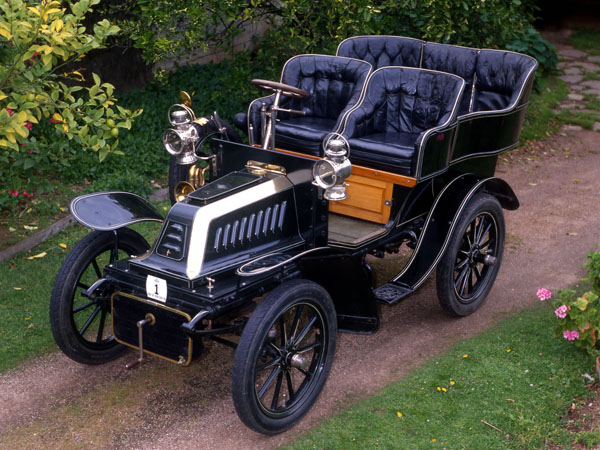De Dion made petrol-engined tricycles from 1895 and launched its first petrol engine four-wheel car in 1899. It could seat four passengers in a configuration which had the front passengers facing back towards the driver and his accompanying passenger. Such a layout was ideal for conversation providing, of course, that their voices could be heard over the noise of the engine but only on rare occasions were four passengers carried since performance was severely effected with this much load and the driver’s vision was not good.
About this time much car development was centred around the use of steam engines which had many limitations. De Dion persuaded Bouton to develop a petrol engine capable of driving a car. This was an air-cooled 402 cc 3.5 hp single cylinder engine which was mounted under the driver’s seat, and drove the rear wheels via a simple gear-change with a separate clutch for each of the two speeds, operated by a wheel on the steering column. By turning it anti-clockwise the low speed clutch was engaged to move the car from rest, while a clockwise turn released the low-speed clutch and actuated the high-speed one.
This single-cylinder engine was also made available to any other manufacturers who were interested in using it and thus had a widespread effect around the world. About one hundred firms in France, Germany, Italy Britain and the United States entered the market with De Dion-powered cars. Whilst many were obscure names the more famous ones included Delage, Renault, Peerless and Pierce-Arrow. The single-cylinder De Dion Bouton continued in production until 1912 with total production climbing up to the region of 20,000 cars. In fact, quite a few are still in use today in Vintage Car Club rallies. The famous London to Brighton Vintage Car Run usually includes several De Dions.
De Dion made its first two-cylinder engine in 1903 and in that new model the engine was moved to the front, under a bonnet and the reverse seating layout was abandoned. This new model was called the Populaire and around 200 units were sold each month. Two engines were offered, a six horsepower unit which usually powered a two-seater, and an eight hp which was fitted to a four-seater body. From this point two-cylinder engines took over from the single-cylinder for most light cars. One of the best known cars to exploit this approach was the Renault whose two-cylinder engine’s reliability and comparative smoothness made it very popular and led to the rise of Renault to the position of leading French car manufacturer by 1914.









